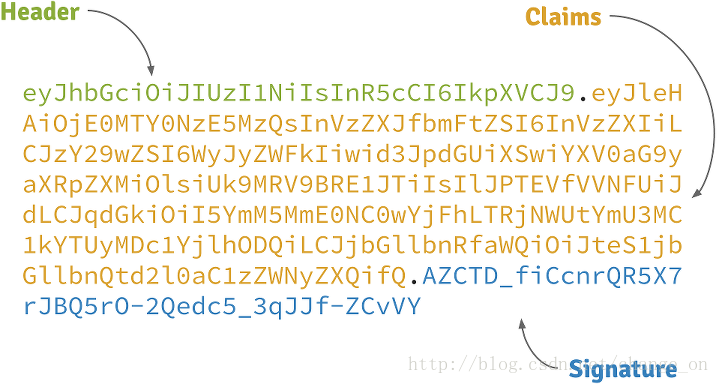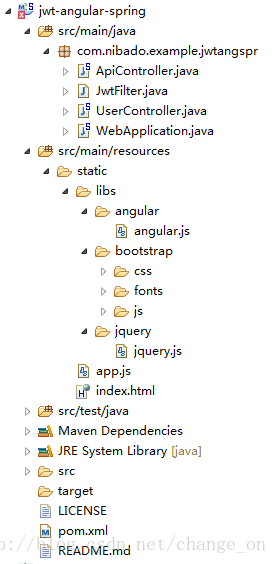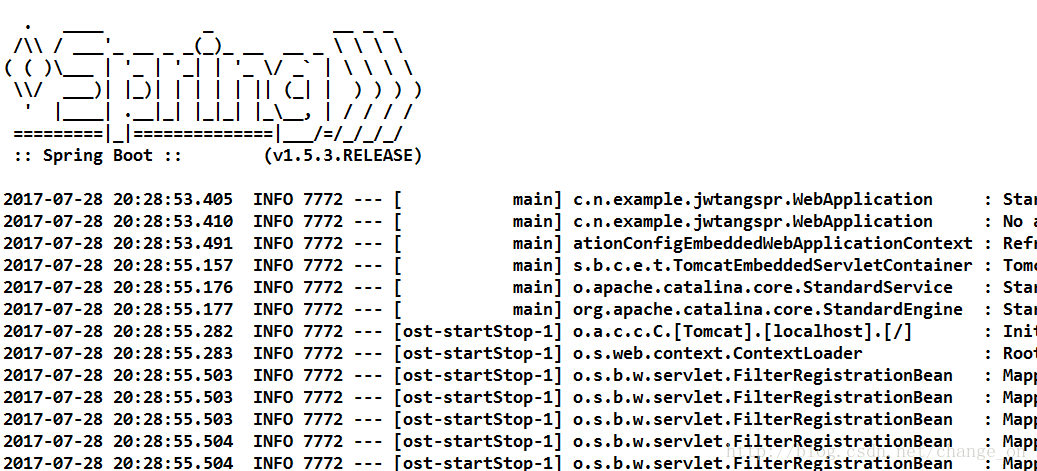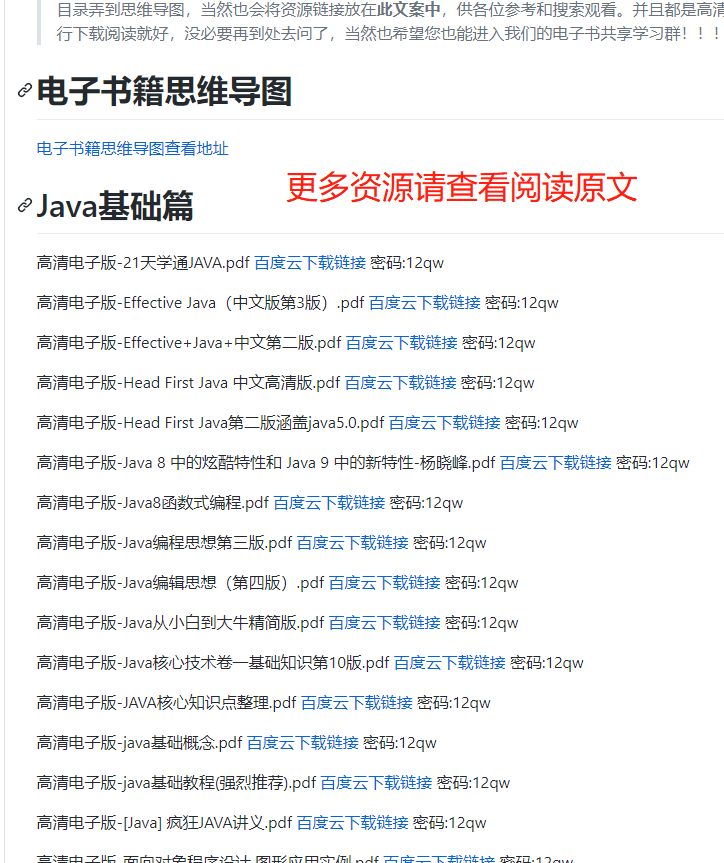还在直接用JWT做鉴权?JJWT真香
jwt是什么?
JWTs是JSON对象的编码表示。JSON对象由零或多个名称/值对组成,其中名称为字符串,值为任意JSON值。JWT有助于在clear(例如在URL中)发送这样的信息,可以被信任为不可读(即加密的)、不可修改的(即签名)和URL - safe(即Base64编码的)。
jwt的组成
Header: 标题包含了令牌的元数据,并且在最小包含签名和/或加密算法的类型 Claims: Claims包含您想要签署的任何信息 JSON Web Signature (JWS): 在header中指定的使用该算法的数字签名和声明
例如:
Header:
{
"alg": "HS256",
"typ": "JWT"
}
Claims:
{
"sub": "1234567890",
"name": "John Doe",
"admin": true
}
Signature:
base64UrlEncode(Header) + "." + base64UrlEncode(Claims),
加密生成的token:

如何保证 JWT 安全
有很多库可以帮助您创建和验证JWT,但是当使用JWT时,仍然可以做一些事情来限制您的安全风险。在您信任JWT中的任何信息之前,请始终验证签名。这应该是给定的。
换句话说,如果您正在传递一个秘密签名密钥到验证签名的方法,并且签名算法被设置为“none”,那么它应该失败验证。
确保签名的秘密签名,用于计算和验证签名。秘密签名密钥只能由发行者和消费者访问,不能在这两方之外访问。
不要在JWT中包含任何敏感数据。这些令牌通常是用来防止操作(未加密)的,因此索赔中的数据可以很容易地解码和读取。
如果您担心重播攻击,包括一个nonce(jti索赔)、过期时间(exp索赔)和创建时间(iat索赔)。这些在JWT规范中定义得很好。
推荐:Java进阶视频资源

jwt的框架:JJWT
JJWT是一个提供端到端的JWT创建和验证的Java库。永远免费和开源(Apache License,版本2.0),JJWT很容易使用和理解。它被设计成一个以建筑为中心的流畅界面,隐藏了它的大部分复杂性。
JJWT的目标是最容易使用和理解用于在JVM上创建和验证JSON Web令牌(JWTs)的库。 JJWT是基于JWT、JWS、JWE、JWK和JWA RFC规范的Java实现。 JJWT还添加了一些不属于规范的便利扩展,比如JWT压缩和索赔强制。
规范兼容:
创建和解析明文压缩JWTs 创建、解析和验证所有标准JWS算法的数字签名紧凑JWTs(又称JWSs): HS256: HMAC using SHA-256 HS384: HMAC using SHA-384 HS512: HMAC using SHA-512 RS256: RSASSA-PKCS-v1_5 using SHA-256 RS384: RSASSA-PKCS-v1_5 using SHA-384 RS512: RSASSA-PKCS-v1_5 using SHA-512 PS256: RSASSA-PSS using SHA-256 and MGF1 with SHA-256 PS384: RSASSA-PSS using SHA-384 and MGF1 with SHA-384 PS512: RSASSA-PSS using SHA-512 and MGF1 with SHA-512 ES256: ECDSA using P-256 and SHA-256 ES384: ECDSA using P-384 and SHA-384 ES512: ECDSA using P-521 and SHA-512
这里以github上的demo演示,理解原理,集成到自己项目中即可。
应用采用 spring boot + angular + jwt
结构图

Maven 引进 : pom.xml
<project xmlns="http://maven.apache.org/POM/4.0.0" xmlns:xsi="http://www.w3.org/2001/XMLSchema-instance"
xsi:schemaLocation="http://maven.apache.org/POM/4.0.0 http://maven.apache.org/xsd/maven-4.0.0.xsd">
<modelVersion>4.0.0</modelVersion>
<groupId>com.nibado.example</groupId>
<artifactId>jwt-angular-spring</artifactId>
<version>0.0.2-SNAPSHOT</version>
<properties>
<maven.compiler.source>1.8</maven.compiler.source>
<maven.compiler.target>1.8</maven.compiler.target>
<commons.io.version>2.4</commons.io.version>
<jjwt.version>0.6.0</jjwt.version>
<junit.version>4.12</junit.version>
<spring.boot.version>1.5.3.RELEASE</spring.boot.version>
</properties>
<build>
<plugins>
<plugin>
<groupId>org.springframework.boot</groupId>
<artifactId>spring-boot-maven-plugin</artifactId>
<version>${spring.boot.version}</version>
<executions>
<execution>
<goals>
<goal>repackage</goal>
</goals>
</execution>
</executions>
</plugin>
</plugins>
</build>
<dependencies>
<dependency>
<groupId>org.springframework.boot</groupId>
<artifactId>spring-boot-starter-web</artifactId>
<version>${spring.boot.version}</version>
</dependency>
<dependency>
<groupId>commons-io</groupId>
<artifactId>commons-io</artifactId>
<version>${commons.io.version}</version>
</dependency>
<dependency>
<groupId>io.jsonwebtoken</groupId>
<artifactId>jjwt</artifactId>
<version>${jjwt.version}</version>
</dependency>
<dependency>
<groupId>junit</groupId>
<artifactId>junit</artifactId>
<version>${junit.version}</version>
</dependency>
</dependencies>
</project>
WebApplication.java
package com.nibado.example.jwtangspr;
import org.springframework.boot.SpringApplication;
import org.springframework.boot.autoconfigure.EnableAutoConfiguration;
import org.springframework.boot.web.servlet.FilterRegistrationBean;
import org.springframework.context.annotation.Bean;
import org.springframework.context.annotation.ComponentScan;
import org.springframework.context.annotation.Configuration;
@EnableAutoConfiguration
@ComponentScan
@Configuration
public class WebApplication {
//过滤器
@Bean
public FilterRegistrationBean jwtFilter() {
final FilterRegistrationBean registrationBean = new FilterRegistrationBean();
registrationBean.setFilter(new JwtFilter());
registrationBean.addUrlPatterns("/api/*");
return registrationBean;
}
public static void main(final String[] args) throws Exception {
SpringApplication.run(WebApplication.class, args);
}
}
JwtFilter.java
package com.nibado.example.jwtangspr;
import java.io.IOException;
import javax.servlet.FilterChain;
import javax.servlet.ServletException;
import javax.servlet.ServletRequest;
import javax.servlet.ServletResponse;
import javax.servlet.http.HttpServletRequest;
import org.springframework.web.filter.GenericFilterBean;
import io.jsonwebtoken.Claims;
import io.jsonwebtoken.Jwts;
import io.jsonwebtoken.SignatureException;
public class JwtFilter extends GenericFilterBean {
@Override
public void doFilter(final ServletRequest req,
final ServletResponse res,
final FilterChain chain) throws IOException, ServletException {
final HttpServletRequest request = (HttpServletRequest) req;
//客户端将token封装在请求头中,格式为(Bearer后加空格):Authorization:Bearer +token
final String authHeader = request.getHeader("Authorization");
if (authHeader == null || !authHeader.startsWith("Bearer ")) {
throw new ServletException("Missing or invalid Authorization header.");
}
//去除Bearer 后部分
final String token = authHeader.substring(7);
try {
//解密token,拿到里面的对象claims
final Claims claims = Jwts.parser().setSigningKey("secretkey")
.parseClaimsJws(token).getBody();
//将对象传递给下一个请求
request.setAttribute("claims", claims);
}
catch (final SignatureException e) {
throw new ServletException("Invalid token.");
}
chain.doFilter(req, res);
}
}
UserController.java
package com.nibado.example.jwtangspr;
import java.util.Arrays;
import java.util.Date;
import java.util.HashMap;
import java.util.List;
import java.util.Map;
import javax.servlet.ServletException;
import org.springframework.web.bind.annotation.RequestBody;
import org.springframework.web.bind.annotation.RequestMapping;
import org.springframework.web.bind.annotation.RequestMethod;
import org.springframework.web.bind.annotation.RestController;
import io.jsonwebtoken.Jwts;
import io.jsonwebtoken.SignatureAlgorithm;
@RestController
@RequestMapping("/user")
public class UserController {
//这里模拟数据库
private final Map<String, List<String>> userDb = new HashMap<>();
@SuppressWarnings("unused")
private static class UserLogin {
public String name;
public String password;
}
public UserController() {
userDb.put("tom", Arrays.asList("user"));
userDb.put("wen", Arrays.asList("user", "admin"));
}
/*以上是模拟数据库,并往数据库插入tom和sally两条记录*/
@RequestMapping(value = "login", method = RequestMethod.POST)
public LoginResponse login(@RequestBody final UserLogin login)
throws ServletException {
if (login.name == null || !userDb.containsKey(login.name)) {
throw new ServletException("Invalid login");
}
//加密生成token
return new LoginResponse(Jwts.builder().setSubject(login.name)
.claim("roles", userDb.get(login.name)).setIssuedAt(new Date())
.signWith(SignatureAlgorithm.HS256, "secretkey").compact());
}
@SuppressWarnings("unused")
private static class LoginResponse {
public String token;
public LoginResponse(final String token) {
this.token = token;
}
}
}
ApiController.java
package com.nibado.example.jwtangspr;
import io.jsonwebtoken.Claims;
import java.util.List;
import javax.servlet.ServletException;
import javax.servlet.http.HttpServletRequest;
import org.springframework.web.bind.annotation.PathVariable;
import org.springframework.web.bind.annotation.RequestMapping;
import org.springframework.web.bind.annotation.RequestMethod;
import org.springframework.web.bind.annotation.RestController;
@RestController
@RequestMapping("/api")
public class ApiController {
@SuppressWarnings("unchecked")
@RequestMapping(value = "role/{role}", method = RequestMethod.GET)
public Boolean login(@PathVariable final String role,
final HttpServletRequest request) throws ServletException {
final Claims claims = (Claims) request.getAttribute("claims");
return ((List<String>) claims.get("roles")).contains(role);
}
}
index.html
<!doctype html>
<html ng-app="myApp">
<head>
<meta charset="utf-8"/>
<meta http-equiv="X-UA-Compatible" content="IE=edge,chrome=1"/>
<title>JSON Web Token / AngularJS / Spring Boot example</title>
<meta name="description" content="">
<meta name="viewport" content="width=device-width">
<link rel="stylesheet" href="libs/bootstrap/css/bootstrap.css">
<script src="libs/jquery/jquery.js"></script>
<script src="libs/bootstrap/js/bootstrap.js"></script>
<script src="libs/angular/angular.js"></script>
<script src="app.js"></script>
</head>
<body>
<div class="container" ng-controller='MainCtrl'>
<h1>{{greeting}}</h1>
<div ng-show="!loggedIn()">
Please log in (tom and sally are valid names)</br>
<form ng-submit="login()">
Username: <input type="text" ng-model="userName"/><span><input type="submit" value="Login"/>
</form>
</div>
<div class="alert alert-danger" role="alert" ng-show="error.data.message">
<span class="glyphicon glyphicon-exclamation-sign" aria-hidden="true"></span>
<span class="sr-only">Error:</span>
{{error.data.message}}
</div>
<div ng-show="loggedIn()">
<div class="row">
<div class="col-md-6">
<h3><span class="label label-success">Success!</span> Welcome {{userName}}</h3>
<a href ng-click="logout()">(logout)</a>
</div>
<div class="col-md-4">
<div class="row header">
<div class="col-sm-4">{{userName}} is a</div>
</div>
<div class="row">
<div class="col-sm-2">User</div>
<div class="col-sm-2"><span class="glyphicon glyphicon-ok" aria-hidden="true" ng-show="roleUser"></span></div>
</div>
<div class="row">
<div class="col-sm-2">Admin</div>
<div class="col-sm-2"><span class="glyphicon glyphicon-ok" aria-hidden="true" ng-show="roleAdmin"></span></div>
</div>
<div class="row">
<div class="col-sm-2">Foo</div>
<div class="col-sm-2"><span class="glyphicon glyphicon-ok" aria-hidden="true" ng-show="roleFoo"></span></div>
</div>
</div>
</div>
</div>
</div>
</body>
</html>
app.js
var appModule = angular.module('myApp', []);
appModule.controller('MainCtrl', ['mainService','$scope','$http',
function(mainService, $scope, $http) {
$scope.greeting = 'Welcome to the JSON Web Token / AngularJR / Spring example!';
$scope.token = null;
$scope.error = null;
$scope.roleUser = false;
$scope.roleAdmin = false;
$scope.roleFoo = false;
$scope.login = function() {
$scope.error = null;
mainService.login($scope.userName).then(function(token) {
$scope.token = token;
$http.defaults.headers.common.Authorization = 'Bearer ' + token;
$scope.checkRoles();
},
function(error){
$scope.error = error
$scope.userName = '';
});
}
$scope.checkRoles = function() {
mainService.hasRole('user').then(function(user) {$scope.roleUser = user});
mainService.hasRole('admin').then(function(admin) {$scope.roleAdmin = admin});
mainService.hasRole('foo').then(function(foo) {$scope.roleFoo = foo});
}
$scope.logout = function() {
$scope.userName = '';
$scope.token = null;
$http.defaults.headers.common.Authorization = '';
}
$scope.loggedIn = function() {
return $scope.token !== null;
}
} ]);
appModule.service('mainService', function($http) {
return {
login : function(username) {
return $http.post('/user/login', {name: username}).then(function(response) {
return response.data.token;
});
},
hasRole : function(role) {
return $http.get('/api/role/' + role).then(function(response){
console.log(response);
return response.data;
});
}
};
});
运行应用

效果


END
顺便给大家推荐一个GitHub项目,这个 GitHub 整理了上千本常用技术PDF,绝大部分核心的技术书籍都可以在这里找到,
GitHub地址:https://github.com/javadevbooks/books
Gitee地址:https://gitee.com/javadevbooks/books
电子书已经更新好了,你们需要的可以自行下载了,记得点一个star,持续更新中..

